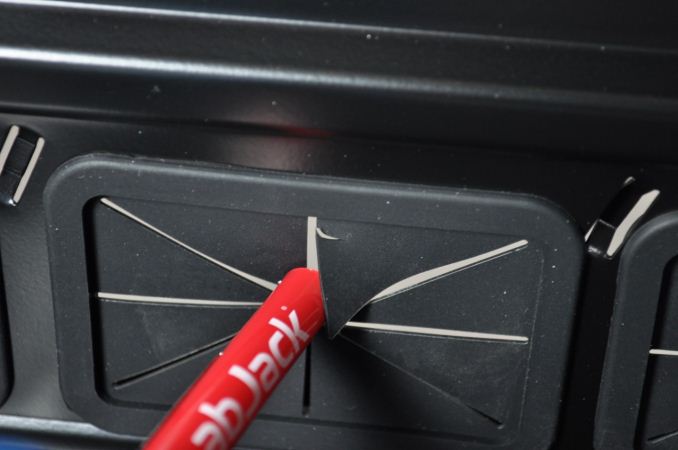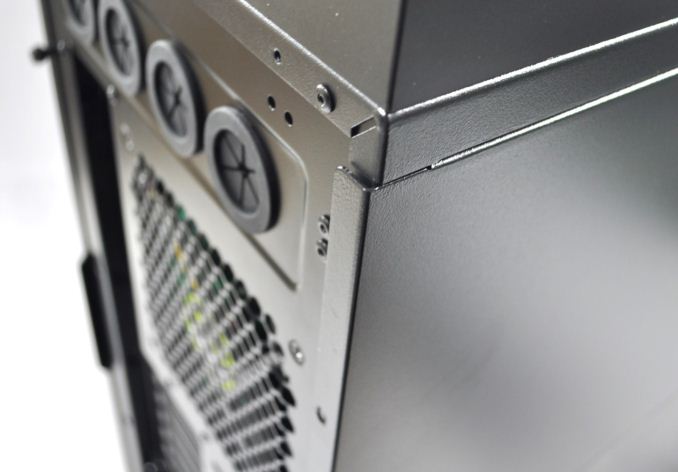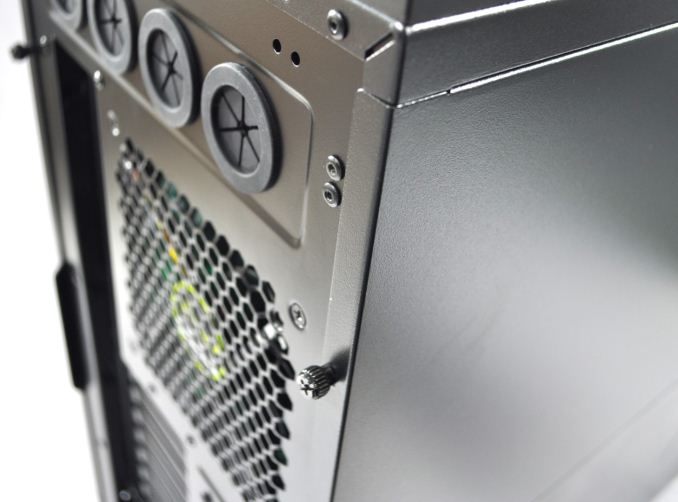Nanoxia Deep Silence 6 Review
by E. Fylladitakis on February 13, 2014 3:00 PM EST- Posted in
- Cases/Cooling/PSUs
- Full-Tower
- HPTX
- Nanoxia
- Case
With the Deep Silence 6, Nanoxia attempted to super-size their first design, the Deep Silence 1,turning it into a spacious, high performance behemoth. The end result is certainly very good, with the high quality a user would expect from Nanoxia and excellent thermal performance. As for space, the Deep Silence 6 has it in spades. Dual CPU and multi-GFX systems will easily fit inside this case, as will multiple liquid-cooling radiators. If desired, it would be possible to fit as many as five 1 × 140mm radiator liquid coolers in the Deep Silence 6 (one at the rear, two at the top, one at the front and one at the bottom of the case), enough for a dual CPU/triple GFX system.
Aesthetics are a subjective factor; while some (including the author) will love the clean, refined design of the Nanoxia Deep Silence 6, others will criticize it and most likely compare the appearnace with that of a refrigerator. Still, we would not go as far as to describe the design as "classic", as Nanoxia does. In fact, the organized lines and clean surfaces of the Deep Silence 6 are the very definition of a "minimalistic" design. A "classic design" and a "design classic" are two entirely different things and Nanoxia is most likely aiming for the latter. The only diminishing factor, if you purchase the version with the side panel window that is, is the second motherboard tray opening, which definitely is functional for users with dual CPU motherboards but will leave a large opening next to any ATX or smaller motherboard.
As with every product ever made, the Nanoxia Deep Silence 6 is not perfect. The most obvious flaw with this case is the massive weight, which will likely result in many of its users looking for gym registrations. Even when empty, the case is almost impossible to handle by anyone without some upper body strength. A set of wheels to replace the feet of the case would be more than a welcome addition, or even selling these as an optional extra. A second minor complaint would be the quality of the rubber grommets around the motherboard tray; they did feel flimsy, so we decided to stress test one by forcefully moving back and forth a bunch of cables through the hole. Soon afterwards, it started cracking. The vast majority of users will never notice such a problem but those who frequently upgrade their systems (or are clumsy at doing so) are likely to end up with a damaged grommet or two.
Super-sizing an existing design can also have significant side effects on the mechanical cohesion of, well, everything. The Deep Silence 6 is no exception; the chassis of the case is exceptionally sturdy and this is why the case is so heavy as well, yet this approach backfires because this chassis bases its structural integrity solely on the metallic frame and the side panels, without any serious support between the four main exterior panels of the chassis. While this probably worked fine with their smaller designs, elongating all of the main panels and doubling the weight of the case weakens the mechanical strength of the design significantly.
As a result, once the side panels are removed, the (empty) chassis frame twists by quite a few minutes, perhaps even over a degree, on its own. This is apparent when installing/removing the side panels, which will not align with the main body of the case until they're screwed in tightly. This is far from a major problem, and the Deep Silence 6 is certainly strong enough to withstand a lot of punishment, yet it is easily noticeable and gives the feeling of a bad mechanical design. On the other hand, extra supports would not only reduce the interior functionality of the case but would probably restrict certain features, such as the front liquid cooling radiator bracket, and they would also increase the weight of an already ridiculously heavy case even further.
Overall, Nanoxia did a great job with the Deep Silence 6, even though it is essentially is a super-sized Deep Silence 1 with added features. It is well made, the design is attractive, it is ludicrously spacious, and it's very versatile. Priced at 199 EUR and currently available for $230 USD or in white for the same price -- though neither option is widely available in the US at present — the Deep Silence 6 is rather competitively priced, steering clear of the price range of other monstrous contraptions like the Corsair 900D and the Cooler Master Cosmos II.
Still, a case of such size and pricing is far from mainstream and has a very specific target audience, which is small and often very demanding. If you're part of that target audience, the DS6 may be precisely what you're looking for. The DS6 does well, and while it's not a clear winner in every respect it also manages to avoid having any serious flaws. If you have the desire (and the requisite muscles) for this sort of case, it's certainly worth a look.













26 Comments
View All Comments
SodaAnt - Thursday, February 13, 2014 - link
Looks like a good case. However, I'm not sure if its just me, but the titles on those graphs just look blurry to me. Also, that's the first time I've ever seen minutes of a degree so casually used in a review, I had to do a double take to make sure I was understanding it right.ddriver - Thursday, February 13, 2014 - link
Yes, looks like it is not the optimal edge smoothing method for this combination of colors and font.JarredWalton - Thursday, February 13, 2014 - link
I think Tracy made the charts manually in some other program (Excel?), and perhaps they got resized somewhere along the way. We'll try to avoid blurry images/fonts next time. :-)noeldillabough - Thursday, February 13, 2014 - link
I love giant cases; easier to put things in and take things out of! That said I wish the exhaust was out the top like the TJ11, to me once I got used to it, exhausting out the top was the superior option.I too would like wheels but the case is already very tall; are there any low profile rollers we could put underneath (no way we'd fit regular wheels under there)
The PC Apologist - Thursday, February 13, 2014 - link
Exhausting out the top is indeed the superior option since as hot air naturally rises, why not go with the flow?That said, the option to exhaust via the top is present. There are two lids on the top that can be raised or lowered. Once raised, it will also hot air to escape via the sides.
lever_age - Thursday, February 13, 2014 - link
Convection has next to zero effect compared to forced airflow with the fans we're talking about here. Orientation doesn't really matter. If you flip one of these cases so the back is now the top or so, you get almost exactly the same temperatures, just maybe a degree off, as shown in tests.The PC Apologist - Thursday, February 13, 2014 - link
Yes I know, the difference in temperatures is negligible. It has always upset me that the temps don't show a larger difference.And yet, because it should theoretically be better, isn't it enough to convince you to choose top over rear?
All else being equal, let's go with the flow.
But if there's a sufficient reason to choose the rear, the rising hot air thing is easily defeated.
lever_age - Thursday, February 13, 2014 - link
No, you may need some special provision (extra height so extra volume overall) to allow sufficient intake from the bottom and exhaust out the top. If you do a layout with motherboard I/O facing up, having cables stick out perpendicular to the ground means more volume or some kind of messiness or contraption to guide them out horizontally. If you have exhausts on the top, dust can readily fall in when the system is not in use.Though depending on layout and restrictions of your living area, some arrangement using top exhaust could be nicer. It just usually doesn't seem as sensible.
JarredWalton - Thursday, February 13, 2014 - link
Best thing about orienting the motherboards 90 degrees rotated is that your GPUs (and in theory expansion cards) hang down from the case and this greatly reduces the stresses on the GPUs, PCIe slots, and motherboard. But simply exhausting out the top without rotating the motherboard doesn't really make much of a difference.Gigaplex - Thursday, February 13, 2014 - link
And then you get your display cables et al sticking out the top of the case rather than the back. Convenient, but ugly. The Silverstone FT03 has an interesting compromise to work around that, however the convenience factor is largely lost.